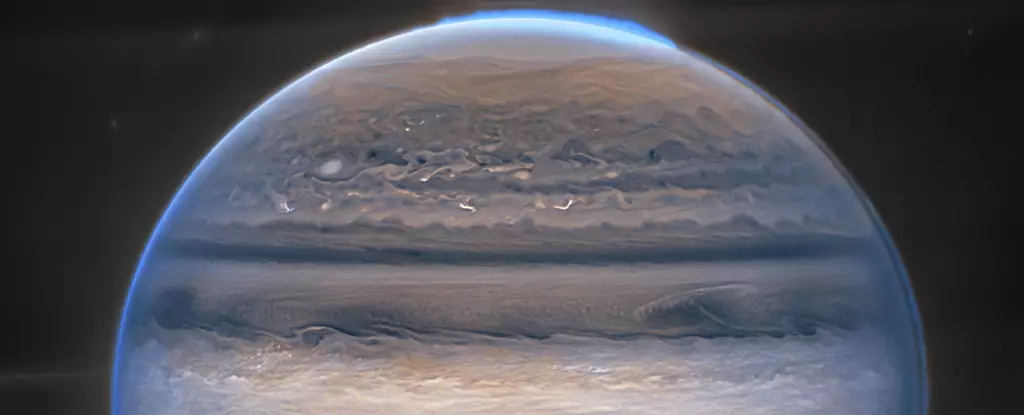Jupiter, the grandest giant in our solar system, challenges our understanding of planetary formation and structure. While Earth offers solid ground under our feet, Jupiter presents a distinct reality: a massive ball of gas with no traditional surface to speak of. This begs the question: What exactly lies beneath the tempestuous clouds that envelop this behemoth?
Unlike the terrestrial planets—Mercury, Venus, Earth, and Mars—that boast solid surfaces composed of rocky material, Jupiter is classified as a gas giant. Its primary constituents are hydrogen and helium, the same elements that predominantly make up stars. The planet’s size is staggering, capable of accommodating over 1,000 Earths within its vast volume. To comprehend its scale further, it’s essential to remember how it dwarfs other planets, making it the largest player in our solar system.
The dynamic nature of Jupiter is not just a matter of size; it’s also about the environmental conditions that prevail in its atmosphere. With wind speeds exceeding 400 mph, Jupiter has storms that are far more intense than the most powerful hurricanes found on Earth. These extreme atmospheric conditions result from the planet’s rapid rotation and immense gravitational pull, creating a turbulent environment that is both mesmerizing and terrifying.
One might wonder what it feels like to navigate the depths of this gas giant. Starting at the upper reaches of its atmosphere, one could descend through layers of hydrogen and helium, where air pressure continuously escalates. Approaching the depths, however, presents a stark contrast to what we experience on Earth. The pressure becomes so formidable that human life would be unsustainable. Any journey inward would likely end in a catastrophic implosion due to the extreme atmospheric conditions.
At approximately 1,000 miles deep, one would encounter a remarkable transformation. The gaseous hydrogen begins to condense into a liquid state, creating what scientists refer to as an ocean of liquid hydrogen. This phenomenon in itself is fascinating, as it defies our conventional understanding of oceans, existing not as water but as a liquid gas.
The further one descends, reaching depths about 20,000 miles from the upper atmosphere, this liquid hydrogen displays properties akin to liquid metal. It’s here that the conditions are so peculiar that only in recent years have scientists been able to replicate such environments in controlled laboratory settings. The intense pressure alters the characteristics of hydrogen, allowing its electrons to move freely, resulting in what is termed ‘liquid metallic hydrogen’.
The Core: A Hot and Chaotic Interior
As one reaches the heart of Jupiter, the concept of a ‘core’ takes on a new meaning. Unlike Earth’s solid core, Jupiter’s interior is believed to consist of complex fluids in a state between solid and liquid—a mix of potentially molten rock, metal, and other exotic substances subjected to immense heat and pressure. The conditions here are nearly unimaginable, with pressures reaching 100 million times greater than Earth’s atmosphere at sea level.
The temperature at Jupiter’s core adds another layer of complexity, with estimates soaring up to around 35,000 degrees Fahrenheit. Such extremes make any theoretical missions into the planet’s depths a near impossibility, as spacecraft would be obliterated long before they could unravel the mysteries of this gas giant’s core.
The Cosmic Guardian: Jupiter’s Role in Our Solar System
While Jupiter may seem inhospitable to life as we know it, it plays a crucial role in safeguarding Earth and the inner planets from potential cataclysmic threats. Its colossal gravitational force acts as a shield, altering the paths of asteroids and comets that might otherwise pose a risk to our planet. Without Jupiter’s significant inclination, Earth might have experienced impacts that could have led to extinction events similar to that which wiped out the dinosaurs.
Interestingly, one of Jupiter’s moons, Europa, offers a contrast to its parent planet. Europa houses a vast subsurface ocean beneath its icy crust, presenting a promising environment where microbial life might exist. Future explorations, such as NASA’s Europa Clipper, aim to investigate this possibility, a ray of hope in our quest for extraterrestrial life.
The exploration of Jupiter continues to challenge and expand our scientific understanding. This gas giant is a realm of extremes, from its vibrant, chaotic atmosphere to the crushing pressures of its depths. As we prepare for future missions that could unveil more secrets about its moons and their potential for harboring life, Jupiter remains an enigmatic titan of the solar system—a force of nature that both complicates and contributes to the delicate balance of cosmic life.


Leave a Reply